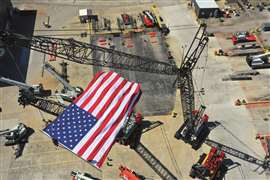Tobias Böhler at Liebherr-Werk Ehingen talks used cranes
15 September 2010

Tobias Böhler is sales director for used cranes at Liebherr-Werk Ehingen, in Germany. Euan Youdale spoke to him about the division and how it is playing a vital role in the company
Böhler began his career at Liebherr in 1994 as a trainee, while studying for an international marketing management qualification. Since then he has spent four years as export manager for tower cranes at Liebherr Group's Spanish subsidiary, Liebherr Industrias Metalicas, SA. In 2003 Böhler joined the mobile crane division, taking him to Liebherr Iberica in Spain and Liebherr-Werk Ehingen in Germany, as head of sales for the Spanish and French speaking markets. In January 2010 he took responsibility for the worldwide used crane department at Liebherr Werk Ehingen.
When was Liebherr's used crane division set up?
It started its activities in the late 1960s, putting major emphasis on the trade-in and resale of used mobile cranes. Trading-in a mobile crane is historically considered as stimulation and support for new cranes sales. It also serves as a pool of near-new cranes for markets where the purchase of a new crane is difficult, due to low rental rates or lack of finance for large investments. Many of our markets, that are nowadays constantly purchasing new cranes, started as purely used crane markets.
Where are Liebherr's used crane facilities based and what do they offer?
In Germany, we maintain three workshops - Ehingen, Oberhausen and Berlin - that are equipped to repair all cranes in our product range with highly skilled and experienced personnel. Additionally, we have Liebherr workshops, specialized in repairing and preparing used cranes in Spain, Great Britain, France, the Netherlands, the USA, the UAE, Saudi Arabia, Australia, Italy, Russia, South Africa and Brazil.
Besides that, of course all technicians of our related service stations and agents are constantly attending courses at our training centre in Ehingen, not only in the latest technologies, but also concerning older cranes.
We offer much more than just the pure trade of machines, however. These are services that make the purchase of used machines at the manufacturer a very attractive alternative. They start with the inspection of machines, repairs and painting and continue with logistics services around the world and assisting with finance questions and they end with hand over and training at customer sites. A customer who purchases a Liebherr mobile crane directly at the factory benefits from a very close relationship to our after sales and service department from the beginning.
Which types of used cranes do you specialise in at Liebherr?
We manage all kinds of used mobile and crawler cranes, as well as other brands. The above-mentioned advantage of purchasing a used machine at Liebherr applies to our own machines. Other brands are usually sold to the trading companies.
How has the economic situation affected sales of used cranes over the last two or three years?
Like the entire crane sector, we have experienced quite some turbulence. This went from one extreme, like a speculation bubble, down to other extremes, for example, lease operations going bust. Especially in 2009 the stock of used machines rose considerably as many new crane orders were only maintained by trading-in machines - previously this was not the case. During this period, the demand for used cranes was rather low. This year, however, so far, we have experienced quite some demand for used cranes again, at least in certain sizes.
Has there been a shift in the types, capacities and ages of used cranes sold during this period?
Nowadays we can say that the demand for used mobile cranes above 80 tonnes is quite good, no matter what age. Smaller cranes, especially the 2- and 3- axle cranes are very hard to sell at reasonable prices.
Which parts of the world are seeing more and less demand for used cranes?
There are some markets for younger used cranes, those being Scandinavia, Russia, Chile and Korea. Older cranes of bigger sizes are seeing demand in South America, Asia and Africa.
How do you see this changing geographically in the future?
I forecast that Latin America, Eastern Europe, Africa and India, particularly, are markets that will be requesting used cranes on a larger scale in coming years. These are also the regions where we are engaging and reinforcing our presence. One example is the creation of our own subsidiary, Liebherr Chile S.A., where we will base technical services for the Spanish speaking regions of South America. The European Community is quite saturated at the moment.
How do you see the future of the used crane sector overall?
Due to the overall crane population and saturation in large markets, we see a tendency to more decentralised sales and trade with requirements in markets like the USA, Brazil and Australia.
What plans does Liebherr have for its used crane division?
We want to maintain and strengthen our status as the number one used crane supplier in the world. This is an integral part of our business model to enable established rental companies to renew their fleet. But, basically, this is what we have done in the past and will be doing in the future.



